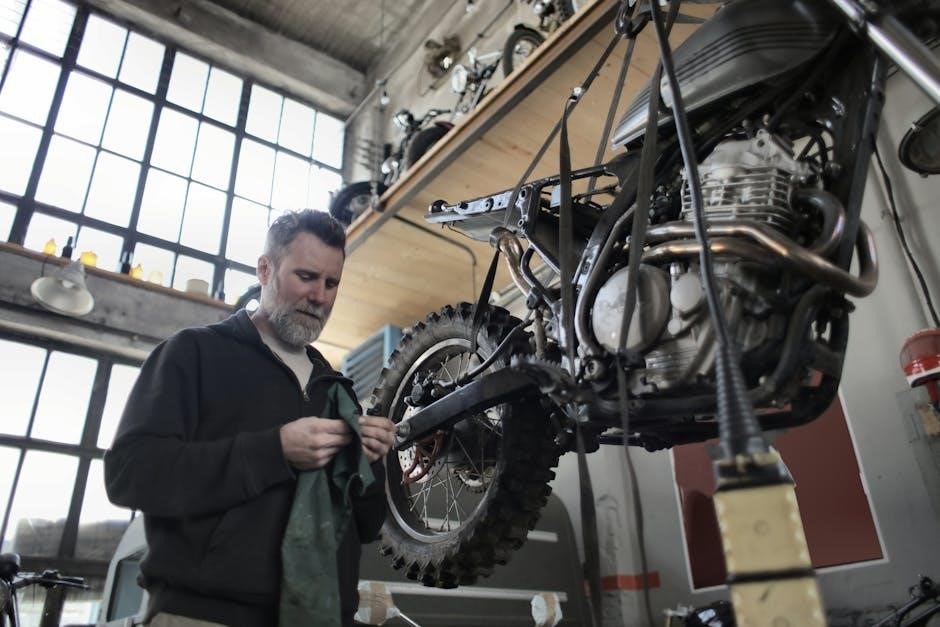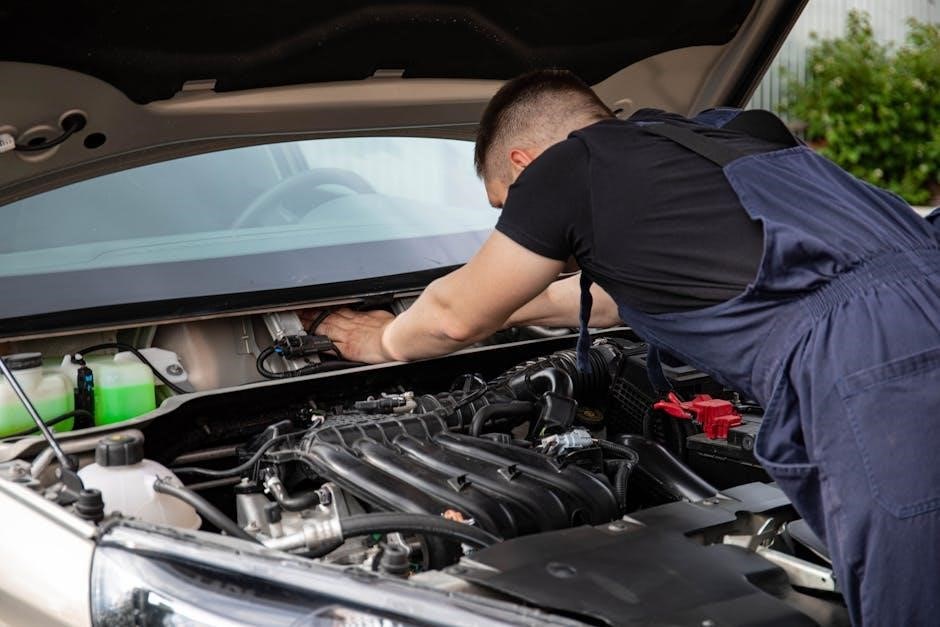The Briggs & Stratton 13.5 HP engine is a reliable power source for various applications. Always refer to the manual for proper installation, operation, and maintenance.
1.1 Overview of the Engine
The Briggs & Stratton 13.5 HP engine is a robust, 4-stroke petrol engine designed for reliable performance in various applications. It is shipped without oil, requiring proper lubrication before operation. The engine features a durable design, ensuring long-term efficiency and power delivery. With a focus on ease of use, it is suitable for both residential and light commercial equipment. Regular maintenance, as outlined in the manual, is essential to maintain optimal performance and extend service life. The engine’s compact size and high power output make it a versatile choice for generators, pressure washers, and other small machinery. Always refer to the manual for specific instructions and safety guidelines.
1.2 Key Features and Specifications
The Briggs & Stratton 13.5 HP engine is a 4-stroke petrol engine, delivering reliable power for various applications. It features a durable design, ensuring consistent performance and longevity. The engine is backed by a 3-Year Limited Global Warranty, covering its horsepower range. Key specifications include its compact size, high power output, and efficiency in fuel consumption. It is designed for both residential and commercial use, making it a versatile choice for equipment like generators, pressure washers, and small machinery. The engine requires quality detergent oil for proper lubrication and is shipped without oil, emphasizing the need for pre-operation preparation. These features make it a trusted option for demanding applications.
1.3 Applications and Uses
The Briggs & Stratton 13.5 HP engine is designed for a wide range of applications, including residential and commercial equipment. It powers generators, pressure washers, lawn mowers, and small machinery. Its reliability and durability make it ideal for demanding tasks requiring consistent power output. The engine is also suitable for water pumps, agricultural equipment, and industrial tools. With its compact design and high performance, it is a versatile choice for both small-scale and heavy-duty operations. Whether for backyard projects or commercial-grade tasks, the 13.5 HP engine delivers the power and efficiency needed to get the job done effectively.

Safety Information and Precautions
Always read and follow safety guidelines in the manual to avoid hazards. Wear protective gear and ensure proper ventilation when operating the engine.
2.1 General Safety Guidelines
Always read and follow the safety guidelines in the manual to ensure safe operation. Wear protective gear, including gloves and eye protection, when handling the engine. Ensure proper ventilation to avoid inhaling harmful fumes. Keep loose clothing and long hair tied back to prevent accidents. Never operate the engine near open flames or sparks. Ensure the engine is placed on a stable, level surface. Keep children and pets away while the engine is running. Familiarize yourself with emergency shutdown procedures. Regularly inspect the engine for wear and tear, addressing any issues promptly. Follow all warnings and cautions provided in the manual to minimize risks and ensure safe operation.
2.2 Warning Labels and Symbols
Warning labels and symbols on the Briggs & Stratton 13.5 HP engine are critical for ensuring safe operation. These labels highlight potential hazards, such as hot surfaces, moving parts, and flammable materials. Always read and understand the meaning of each symbol before operating the engine. Common warnings include wearing eye protection, avoiding loose clothing, and keeping children away. The manual also emphasizes the importance of following all cautionary labels to prevent accidents. Familiarize yourself with the symbols, such as the choke warning and fuel shutoff indicators, to ensure proper handling. Briggs & Stratton includes these labels to comply with safety regulations and protect operators from harm.
2.3 Hazardous Materials and Handling
Handling hazardous materials associated with the Briggs & Stratton 13.5 HP engine requires careful attention to safety protocols. Fuel, oil, and other chemicals must be managed properly to avoid risks. Always wear protective gloves and eyewear when handling these substances. Ensure proper ventilation when working with flammable materials to prevent inhalation of fumes. Dispose of waste materials, such as used oil and filters, according to local regulations. Keep these substances away from open flames or sparks to reduce fire hazards. Refer to the manual for specific guidelines on handling and storing hazardous materials safely. Proper precautions minimize environmental impact and ensure operator safety.

Installation and Setup
Proper installation involves unpacking, inspecting, and preparing the engine. Ensure all components are securely mounted and aligned. Fill the engine with recommended oil before startup.
3.1 Unpacking and Inspection
Begin by carefully unpacking the engine to avoid damage. Inspect for any signs of shipping damage or wear. Verify all components, such as the spark plug, air filter, and fuel tank, are included. Ensure the engine is complete and no parts are missing. Check for proper labeling and documentation, including the manual. Before proceeding, confirm the engine model matches your requirements. Look for any visible defects or issues that may require immediate attention. If damage is found, contact Briggs & Stratton support. This step ensures a smooth installation process and prevents potential operational issues later. Always refer to the manual for specific guidance.
3.2 Mounting the Engine
Mounting the Briggs & Stratton 13.5 HP engine requires careful planning to ensure stability and proper alignment. Always refer to the manual for specific mounting instructions tailored to your engine model. Choose a level, sturdy surface that can support the engine’s weight and operational forces. Use the engine’s built-in mounting points and secure it with appropriate bolts or brackets. Ensure the driveshaft aligns correctly with the equipment it powers to avoid vibration and wear. Tighten all bolts securely, but avoid overtightening, which could damage the engine. Double-check the alignment after installation to ensure optimal performance and longevity. Proper mounting is essential for safe and efficient operation.
3.3 Oil and Fuel Requirements
Proper oil and fuel are essential for the Briggs & Stratton 13.5 HP engine’s performance and longevity. Use high-quality detergent oil meeting API SF or SG standards, with viscosity ranging from SAE 10W-30 to SAE 30, depending on temperature. The engine is shipped without oil, so fill it before starting. Avoid overfilling, as this can damage the engine. For fuel, use clean, fresh gasoline with no more than 10% ethanol; Regularly check the fuel filter and lines for contamination or blockages. Refer to the manual for specific oil and fuel recommendations to ensure optimal performance and compliance with warranty terms. Always follow these guidelines to maintain engine health and efficiency.

Operating the Engine
Start the engine with the choke fully engaged, then gradually adjust the throttle for smooth operation. Monitor oil levels and ensure proper fuel flow for consistent performance.

4.1 Starting Procedures
To start the Briggs & Stratton 13.5 HP engine, ensure the throttle is in the “start” or “slow” position. Prime the engine by pressing the primer bulb 2-3 times until it feels firm. Engage the choke fully if the engine is cold. Pull the starter cord firmly until the engine starts. Once running, gradually move the choke to the “run” position. Allow the engine to warm up for 1-2 minutes before increasing the throttle. Always check for oil leaks and ensure proper fuel flow before operation. Refer to the manual for detailed starting instructions specific to your model. Proper starting ensures optimal performance and longevity.
4.2 Speed and Load Management
Proper speed and load management is essential for optimal performance of the Briggs & Stratton 13.5 HP engine. Always adjust the throttle gradually to avoid sudden changes that may strain the engine. Monitor the engine’s workload to ensure it does not exceed recommended limits, as overloading can lead to overheating or reduced efficiency. Maintain proper oil levels and fuel flow before adjusting speed or load. Avoid operating the engine at extreme speeds for extended periods. Refer to the manual for specific guidelines on load management to ensure longevity and reliable operation. Proper management helps maintain engine efficiency and prevents potential damage.
4.3 Shutdown and Storage
Proper shutdown and storage of the Briggs & Stratton 13.5 HP engine are crucial for maintaining its performance and longevity. Always allow the engine to cool down before shutting it off. Turn off the fuel supply and ensure all accessories are disconnected. For storage, drain the fuel tank to prevent stale fuel buildup, and clean the engine thoroughly to remove dirt or debris. Check for any fluid leaks before storing. Store the engine in a dry, well-ventilated area, away from direct sunlight. Cover the engine with a protective cover to shield it from dust and moisture. Regularly inspect stored engines for signs of damage or wear. Proper storage ensures the engine remains in good condition for future use.

Maintenance and Servicing
Regular maintenance ensures optimal performance and longevity. Follow the manual for oil changes, air filter cleaning, and spark plug checks. Address wear and tear promptly.
5.1 Oil Change and Lubrication
Oil is vital for the engine’s performance and longevity. Always use high-quality detergent oil meeting Briggs & Stratton specifications. Check the oil level regularly, ensuring it reaches the dipstick’s “FULL” mark. Change the oil every 50 hours of operation or as specified in the manual. Before starting a new engine, fill it with the recommended oil type, as it is shipped without oil. Avoid overfilling, as this can damage the engine. Properly dispose of used oil to protect the environment. Regular lubrication prevents wear and tear, ensuring smooth operation. Refer to the manual for oil capacity and viscosity recommendations.
5.2 Air Filter Cleaning and Replacement
Regular air filter maintenance is essential for optimal engine performance. Clean or replace the air filter every 50 hours of operation or as specified in the manual. Turn off the engine, allow it to cool, and remove the air filter housing. Inspect the filter for dirt or damage; clean it with compressed air if reusable. Replace damaged or excessively worn filters immediately. Use only genuine Briggs & Stratton parts to ensure compatibility. Properly dispose of old filters to protect the environment. A dirty or clogged air filter can reduce engine efficiency and increase fuel consumption. Always follow the manual’s guidelines for cleaning and replacement procedures.
5.3 Spark Plug Maintenance
Regular spark plug maintenance ensures proper engine performance and fuel efficiency. Always refer to the manual for specific instructions. Locate the spark plug, shut off the engine, and allow it to cool. Use a spark plug socket to remove the plug. Inspect for wear, fouling, or damage. Clean the plug with a wire brush if reusable. Replace the spark plug with a new one of the correct type specified in the manual. Ensure the gap is set to the recommended specification (typically 0.030–0.035 inches). Tighten the spark plug securely but avoid over-tightening. Recheck the gap after installation. Proper maintenance prevents engine misfires and ensures reliable operation.
5.4 Checking and Replacing the Fuel Filter
Regularly inspecting and replacing the fuel filter is crucial for maintaining engine performance. Locate the fuel filter, typically near the fuel tank or carburetor. Turn off the engine and allow it to cool. Remove the filter by loosening the retaining clips or fittings. Inspect for dirt, debris, or contamination. If damaged or clogged, replace it with a new filter compatible with your engine. Dispose of the old filter responsibly. Reinstall the new filter securely, ensuring all connections are tight. Refer to the manual for specific torque specifications. Replace the fuel filter every 50 hours of operation or as recommended to prevent fuel flow issues and ensure optimal engine efficiency.

Troubleshooting Common Issues
Identify common issues like engine not starting or overheating. Regular checks of oil, air filter, and spark plug ensure smooth operation and prevent breakdowns.
6.1 Engine Not Starting
If the engine fails to start, check the fuel level and ensure the fuel valve is open. Verify that the choke is properly engaged; Inspect the spark plug for wear or fouling and replace it if necessary. Ensure the air filter is clean or replace it if clogged. Check for any blockages in the fuel line or carburetor. Consult the manual for specific troubleshooting steps related to your model. Regular maintenance, such as oil changes and filter cleaning, can help prevent starting issues. Always refer to the manual for detailed diagnostic procedures.
6.2 Engine Overheating
Engine overheating can occur due to insufficient oil, a blocked air filter, or improper fuel flow. Always ensure the oil level is adequate and use the recommended viscosity. Clean or replace the air filter if it is clogged with debris. Check the fuel line for kinks or blockages and ensure the carburetor is functioning properly. Overloading the engine or operating it in high-temperature environments can also cause overheating. Refer to the manual for specific cooling system maintenance. If overheating persists, stop the engine immediately to prevent damage. Regular maintenance, such as oil changes and filter cleaning, can help avoid this issue.
6.3 Low Power Output
Low power output in the Briggs & Stratton 13.5 HP engine can result from a dirty or clogged air filter, insufficient oil, or improper fuel mixture. Regularly clean or replace the air filter to ensure proper airflow. Check the oil level and viscosity, ensuring it matches the manual’s recommendations. A clogged fuel filter or faulty carburetor can also restrict fuel flow, reducing power. Inspect the spark plug for fouling or wear and replace it if necessary. Overloading the engine or operating it in high-altitude conditions may also cause reduced performance. Addressing these issues through routine maintenance can restore optimal power output and efficiency.

6.4 Oil Leaks and Other Fluid Issues
Oil leaks in the Briggs & Stratton 13.5 HP engine can occur due to worn gaskets, loose connections, or damaged seals. Inspect the engine regularly for signs of leaks around the oil drain plug, valve cover, or crankcase. Tighten any loose bolts or replace faulty gaskets. Excessive oil consumption may also indicate a problem with piston rings or cylinder walls. Proper disposal of used oil and filters is essential to prevent environmental harm. Always refer to the manual for correct oil levels and types to avoid overfilling, which can lead to leaks or engine damage. Address fluid issues promptly to maintain engine performance and longevity.

Repair and Replacement of Parts
For repairs, always refer to the Briggs & Stratton manual. Use genuine parts to ensure compatibility and performance; Follow safety guidelines and proper procedures for replacements.
7.1 Identifying Wear and Tear
Regularly inspect the engine for signs of wear and tear, such as oil leaks, corroded parts, or worn-out components like spark plugs or air filters. Check for loose connections or damaged hoses, which can lead to poor performance. Refer to the manual for specific guidance on identifying wear in critical areas like the carburetor or fuel system. Always use genuine Briggs & Stratton parts for replacements to ensure compatibility and longevity. Addressing wear early prevents costly repairs and extends the engine’s lifespan. For detailed instructions, consult pages 13 and 17 of the manual, which outline maintenance schedules and part replacement procedures.
7.2 Replacing the Air Filter Housing
To replace the air filter housing on your Briggs & Stratton 13.5 HP engine, start by purchasing a genuine replacement part from an authorized dealer. Ensure the engine is turned off and cool before beginning. Remove the old housing by disconnecting any mounting brackets or clips, taking care not to damage surrounding components. Install the new housing by aligning it properly and securing it with the provided hardware. Tighten all connections firmly but avoid over-tightening. Finally, replace the air filter with a new one and ensure all seals are intact for proper engine performance. Consult pages 10 and 13 of the manual for detailed instructions.
7.3 Servicing the Carburetor
Servicing the carburetor of your Briggs & Stratton 13.5 HP engine involves careful cleaning and inspection. Begin by disconnecting the fuel line and removing the carburetor from the engine. Soak the carburetor in a mixture of solvent and water to remove dirt and grime. Use a small brush to clean out the jets and passages. Inspect the gaskets and replace them if worn or damaged. Reassemble the carburetor and reinstall it, ensuring all connections are secure. Check for leaks and test the engine’s performance after servicing. Refer to page 17 of the manual for specific guidance on cleaning and reassembling the carburetor components.
7.4 Replacing the Spark Plug Wire
Replacing the spark plug wire on your Briggs & Stratton 13.5 HP engine is essential for maintaining proper ignition. Start by disconnecting the spark plug wire from the plug and the ignition coil. Remove any clips or holders securing the wire. Inspect the wire for cracks, wear, or damage; replace it if necessary. Install the new wire, ensuring it is securely connected to both the spark plug and the ignition coil. Use a spark plug wire with the correct resistance rating, as specified in the manual. Tighten all connections firmly and test the engine to ensure it runs smoothly. Regular replacement prevents misfires and ensures reliable engine performance.

Warranty and Support
Briggs & Stratton offers a 3-Year Limited Global Warranty for engines. Contact their support team for assistance, and locate authorized service centers for genuine parts and repairs.
8.1 Understanding the Warranty Terms
The Briggs & Stratton 13.5 HP engine is backed by a 3-Year Limited Global Warranty, covering manufacturing defects under normal use. Registration within 30 days of purchase is recommended. The warranty includes parts and labor for repairs due to defects in materials or workmanship. Proper maintenance, as outlined in the manual, is required to maintain warranty validity. Proof of purchase and adherence to operational guidelines are essential for warranty claims. Certain components, such as air filters and spark plugs, may have shorter coverage periods. For detailed terms, refer to the official warranty document provided with your engine or available online.
8.2 Contacting Briggs & Stratton Support
For assistance with your Briggs & Stratton 13.5 HP engine, contact their dedicated support team. Call their toll-free customer service number at 1-800-274-4471 for troubleshooting, parts inquiries, or warranty-related questions. Visit their official website at www.briggsandstratton;com for detailed support resources, including FAQs and service locator tools. Email inquiries can be sent through their online contact form. Ensure to have your engine model number and serial number ready for faster assistance. Support is available Monday through Friday, 8:00 AM to 5:00 PM CST. For immediate help, refer to the operator’s manual or the online knowledge base for troubleshooting guides and maintenance tips.
8.3 Finding Authorized Service Centers
To locate an authorized Briggs & Stratton service center, visit their official website at www.briggsandstratton.com and use the “Service Locator” tool. Enter your location or ZIP code to find nearby certified dealers. Ensure your engine is serviced by professionals to maintain warranty validity and performance. Call their customer support at 1-800-274-4471 for assistance in finding a service center. Always provide your engine’s model and serial number for accurate support. Authorized centers offer genuine parts, expert diagnostics, and reliable repairs, ensuring your engine operates at peak efficiency. Regular servicing at these centers is crucial for extending the engine’s lifespan and maintaining its warranty coverage.






